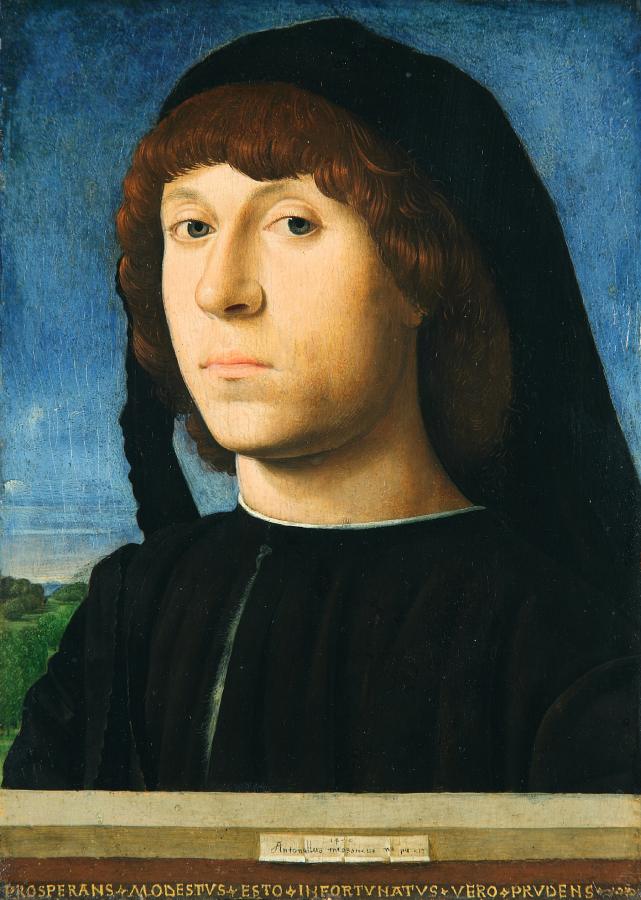Antonello da Messina (c.1430-1479)
Ritratto di giovane (Portrait of a Young Man)
1478
Oil on walnut panel, 20.4 x 14.5 cm
Gemäldegalerie, Berlin
An inconspicuous note, stuck as if by chance to the parapet in the foreground, states the year in which the portrait was painted and testifies self-confidently: “Antonello from Messina painted me” (Antonellus messaneus me pinxit). This work, painted a year before the artist’s death, is thought to be the last of some twelve surviving portraits by the Sicilian. It was made in his home town, to which Antonello had returned in summer 1476 after a stay in Venice lasting somewhat more than a year. It is by far the smallest of his portraits and at the same time the only one that shows the figure against the backdrop of a landscape rather than a uniformly dark background. A radiant blue evening sky lies behind the young man, who, dressed all in black, looks at us slightly from above over the small parapet. His characteristic facial features are shown individually. The light flesh tones and details such as the eyelashes and eyebrows, as well as the fur trimming on his doublet, are rendered with the greatest care. Above his slightly wavy, red-brown hair is placed headgear typical of the time, a cap whose fastening (Italian: becho) hangs down at the side, laid to the front above his right shoulder. Even with the naked eye, an alteration can be discerned in this place. The sleeve, which was originally to have been wider and was intended to extend almost to the left edge of the picture, was painted smaller to make the space needed for a view of the landscape. With great compactness and the accuracy of a miniature, the artist evokes a broad plain with trees. Long shadows, scattered clouds and the horizon coloured by twilight provide an atmospheric mood. The inspiration of models from the Netherlands in the style of Hans Memling is unmistakable. A recently conducted thorough technical analysis of the painting succeeded in dispelling once and for all doubts that had occasionally been expressed about whether the landscape was executed by the artist’s own hand. The sequence of the various layers of paint is clear evidence that the figure and the landscape were painted at the same time. No black underlayer of paint on the background could be demonstrated. Antonello obviously decided suddenly to alter his plans in the middle of the process of producing the work.
We do not know who had himself portraited in such an unusual manner, but both the dress of the sitter and the early provenance of the painting from the ownership of a Venetian family suggest that it was commissioned by a person from that city.
The golden inscription that was added beneath the parapet, perhaps when the work was re-framed, is not original. It lends a retrospective moralising touch to the portrait, admonishing the beholder: “Be modest in prosperity, but prudent in misfortune” (PROSPERANS • MODESTVS • ESTO • INFORTVNATVS • VERO • PRVDENS). (Gemäldegalerie)
